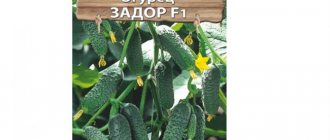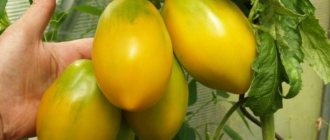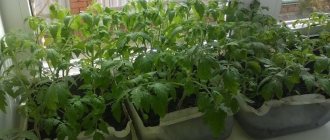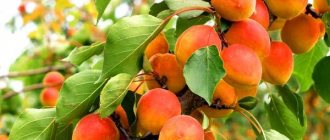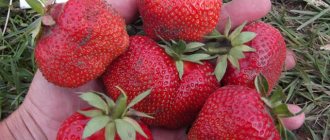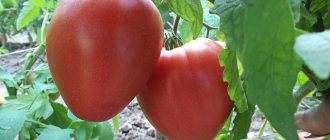An indeterminate late salad variety with ribbed fruits, intended mainly for growing in protected soil (under a film cover) on private farms. The bush is powerful, tall, and needs staking and pinching. Relatively resistant to diseases.
Ripe tomato Cheerful neighbor. Photo: @marinka_ogorod
Description of the variety
The Cheerful Neighbor tomato is a typical indeterminate variety. This means that it has almost unlimited growth, which is stopped at a certain stage so that it has time to form normal fruits and ripen. The variety is mid-early, about 115-120 days pass from the moment the seeds are sown to the time the harvest ripens. It is recommended to grow bushes with one, maximum two stems. The height of the bush reaches from 1.8 to 2 m, therefore it requires mandatory pinching, as well as gartering of bushes.
Agricultural technology
It is advisable to grow the variety as seedlings. It is best to calculate the time for sowing seeds yourself to take into account the climatic characteristics of the region and the method of cultivation. If you listen to the originator, he suggests sowing seeds from February to March, and replanting in April - May. Picking is carried out at the stage of 2 true leaves. Plants aged 60-65 days are suitable for replanting. The recommended planting density will depend on the method of forming the bush. If a tomato is formed into 1 stem, then up to 4 plants can be planted per 1 square meter; if there are 2 stems, then 3 bushes. After transplantation, the crop is tied to a support, and pinching is carried out as necessary. Some gardeners write that our hero can withstand a load of 3-4 stems, although in this case the fruits are smaller and the harvest ripens later. Agricultural technology corresponds to the culture as a whole. The plant must be watered on time, fertilizing is carried out mainly with mineral fertilizers, prevention from diseases and pests is mandatory.
Fruit characteristics
Tomato fruits have an original, recognizable shape - rounded and flattened, with a grooved surface reminiscent of a peeled tangerine. The color of the fruit is bright red. Cheerful Neighbor tomatoes reach up to 15 cm in diameter, weigh up to 350 g, and many chambers are formed in the middle of the fruit for the formation of seeds. The pulp of the fruit is very soft, fleshy, juicy, with a rich tomato taste. The fruits are tied in clusters of 4-8 tomatoes in one cluster.
The yield from 1 plant is from 5 to 6 kg, and from 1 sq. m comes out to 15 to 20 kg. The fruits are well transported and suitable for storage for some time. If you pick slightly unripe fruits, the shelf life can be extended due to the time when they turn red during storage and transportation. In culinary terms, they are especially well suited for preparing various salads, juices, and canning.
The variety is also universal in terms of geographic zoning, as it grows well in both southern and middle latitudes, and in the northern zone it is better to grow them in greenhouses.
Description
The height of the plant is about 1.8-2.0 m, the foliage is oblong and dark green in color, the inflorescence is standard. The fruit cluster is heavy, forming 4-8 ovaries. An average of 5 clusters are formed along the central stem.
The shape of the tomatoes is flattened, there are ribs over the entire surface, the peel is smooth, the density of the ripened fruits is average. “The Cheerful Neighbor” won the hearts of gardeners with its size - the diameter of the tomato is about 15 cm, and the average weight of one fruit ranges from 250 to 400 grams. A ripe tomato is deep red in color, the flesh is fleshy, tender, juicy and multi-chambered. The average tomato has more than 6 seed nests. The taste is rich, sweet and sour with a characteristic bright aroma.
The State Register classified “Cheerful Neighbor” as a late variety because the time of primary fruiting is about 110-115 days. Fruits until October or the first frost. The declared marketable yield in film greenhouses is about 9 kg. per 1 sq. m. The tomato easily tolerates short-term dry periods and continues to form ovaries in hot weather. However, during cold and rainy periods the processes slow down.
“Cheerful Neighbor” is intended to be eaten in its natural form. Also suitable for preparing preparations - the juice comes out of excellent quality and is quite thick.
Advantages of the variety
The strengths of the Cheerful Neighbor tomatoes include the following characteristics:
- large fruits of high quality presentation;
- high productivity;
- versatility: grown in open ground and in greenhouse conditions;
- transportable;
- relatively long shelf life.
Disadvantages of the variety
As reviews show, the Cheerful Neighbor tomatoes have no critical shortcomings. At the same time, some features make the process of growing them more labor-intensive, namely:
- need for garter;
- mandatory stepsoning.
The best varieties of tomatoes for Siberia
Temperature changes in Siberia are particularly pronounced. Summer is short, the air is hot and dry during the day, and frost sometimes occurs at night. Stress-tolerant tomatoes, which mainly include new varieties of hybrids, are taking root in this region.
Summer residents of Western Siberia prefer varieties such as Alsou or Siberian early ripening, while in the east Siberian Express and Gina are popular. But there are other varieties that are suitable for Siberian gardens.
For the greenhouse
There are varieties designed specifically for greenhouses in Siberia.
Altai strongman
Unusual fruits with a distinct taste.
Universal, used for preparations and salads.
Greek
Tall bushes producing fleshy raspberry tomatoes with thin skin.
Early ripening, excellent taste and long-lasting presentation.
Scarlet Mustang
Elongated, original fruits.
With regular feeding and proper care, one plant brings 5 kg of harvest.
Your Majesty
Very tall tomatoes that require garter.
Large, yellow, heart-shaped tomatoes that can weigh up to 1.5 kg. Salad variety.
For open ground
In Siberian territories, those varieties that are not picky about the composition of the soil and do not lose their ovaries during cold weather take root.
Abakan pink
Bred in Altai, perfectly adapted to the climate of Eastern Siberia.
Large ribbed fruits delight gardeners with their fleshy pulp and pleasant taste.
Chinese heat resistant
An early ripening variety, resistant to the heat typical of July in Khakassia and the Krasnoyarsk Territory, but at the same time adapted to the climate of Siberia.
Pinkish tomatoes are suitable for pickling.
Canopus
An unpretentious large-fruited species, the advantage of which is late blight resistance.
Yamal Early ripening
A large-fruited variety that can survive in the Far North.
King of Siberia
Giant tomatoes with thin skin, weighing up to 1 kg.
Due to the heaviness of the fruits, the bushes require staking and careful care.
Features of growing tomatoes
Tall tomatoes are grown using the same technology as low-growing ones, but with some distinctive features. All measures in the agricultural technology of the Cheerful Neighbor tomatoes can be divided into the following stages:
- Preparing the area for future beds.
- Preparation of soil mixture for seedlings.
- Preparing tomato seeds for sowing.
- Sowing and caring for seedlings.
- Planting in beds and caring for bushes.
Agricultural technology for tomato cultivation
The mid-season tomato Cheerful Neighbor is designed for growing in protected soil conditions. The tomato is characterized by an average ripening period, excellent taste, and universal use in cooking.
READ MORE: Strawberry Jolie description of the variety, reviews from gardeners photos
The description of the variety indicates that when growing tomatoes it is better to use the seedling method. Sowing seeds for seedlings is carried out in March. Before planting, the seed is treated with an aqueous solution of potassium permanganate and a growth stimulator.
Prepared soil is poured into containers, lightly compacted, furrows 1 cm deep are made and watered with warm water. After planting the seeds, the container is covered with film or glass to create a greenhouse effect, which ensures the friendly emergence of seedlings.
The peculiarities of growing the variety consist in carrying out agrotechnical measures related to stimulating crop growth and strengthening the root system. At the stage of formation of 2-3 true leaves, picking is carried out in separate containers.
When planting in a permanent place, the bushes are placed at a distance of 40 cm from each other, 60 cm are left between the rows. It is recommended to place 3 bushes per 1 m². The description of the process of growing a crop includes a system of agrotechnical measures to care for the plant.
An important stage of cultivation is to ensure timely watering, which is recommended to be done at the root. To do this, use warm water. In order to distribute moisture evenly and prevent intense evaporation, the soil is mulched.
Black fiber and organic materials (hay, straw, leaves) are used as mulch. This action helps prevent the growth of weeds. You can install a drip irrigation system in the greenhouse, which will significantly save time and increase crop productivity.
At each stage of plant development, it is necessary to regulate the quantitative composition of fertilizers. For preventive purposes, bushes are treated against diseases and biological pests. The plant requires periodic loosening of the soil and hilling.
Reviews from those who grew the Cheerful Neighbor variety testify to the unusual shape of the bright red fruits and exceptional taste.
Margarita Antonova, 56 years old, Kolomna.
Last season, on the recommendation of neighbors, I purchased a bag of seeds of the Cheerful Neighbor variety. I grew it through seedlings in the usual way for tomatoes. After forming 1 flower cluster, I planted the bushes in a greenhouse.
Tall bushes had to be tied to a support. I was pleased with the clusters of ripening tomatoes and their relief shape. Funny tomatoes, even if you send them to an exhibition, they have an amazing taste and bright color.
The description of the variety and the declared characteristics fully correspond to the cultivated crop.
Mikhail Vorobyov, 59 years old, Pyatigorsk.
Site preparation
First of all, taking into account the predecessors that grew on the ground last season, they choose where to plant tomatoes. According to the principles of crop rotation, excellent predecessors for tomatoes will be cabbage, cucumbers, legumes, root vegetables, grains, and green manure herbs. On the contrary, tomatoes should not be planted after potatoes, peppers, and eggplants. It should also be taken into account that you cannot plant different varieties of tomatoes next to each other, because they will pollinate each other and the distinctive characteristics of both varieties will be lost, not to mention the impossibility of using the seeds collected from them next year.
In October-November, organic matter (manure, compost) is added to the soil, after which deep plowing is carried out. Instead, in August you can sow green manure grasses or root crops, which will gain weight in October-November and are plowed without mowing or collecting. The green mass of herbs and the pulp of root crops will become a natural fertilizer, which will rot over the winter and be processed by worms and bacteria.
An alternative to organics can be mineral fertilizers, which are distributed in dry form over the surface, namely: superphosphates (40-50 g per 1 sq. m), potassium nitrate (10-15 g per 1 sq. m) and ammonium nitrate (10- 25 g per 1 sq. m). After applying mineral fertilizers, plowing is also carried out.
Important! Plowing the plot for the winter helps to freeze out the larvae of pests and pathogens of tomatoes.
The best varieties of tomatoes for the Urals
The climate of the Middle and Southern Urals is moderate, with warm, sunny summers, but the soil does not have a variety of mineral composition. In the Northern and Subpolar Urals the impact of subarctic winds is already being felt. During the cold season, the ground freezes very much, so southern varieties of tomatoes do not take root or produce a meager harvest. Tomatoes of Siberian selection are suitable for the Urals.
Features of choice
The Ural climate is varied, so to obtain juicy tomatoes, the variety is chosen in accordance with the weather conditions of the region. The best species are those that do not require painstaking care, do not freeze when the temperature drops, and ripen quickly during the short summer.
Preparing soil for seedlings
For these purposes, you can buy a ready-made mixture, but this will increase the overall costs of growing tomatoes. You can use regular soil, but it will not give the same results as nutrient mixtures. Therefore, you need to prepare the soil for seedlings yourself, mixing the following components in equal proportions: regular soil, turf soil or sawdust, peat, river silt, then add 2 cups of ash to 10 liters of this mixture.
In some sources you can find information about the need to add humus, but others say that it unnecessarily heats the mixture, which inhibits the germination of seeds until they die. The last observation is more correct, but this can be verified experimentally by allocating a couple of cups of seeds to the mixture containing humus.
When the mixture is ready, it should be calcined in the oven to disinfect it from pathogens and pests. An alternative is treatment with a 1-2% solution of potassium permanganate, which is used to soak the mixture.
Reviews
I grow the Cheerful Neighbor variety of tomatoes in greenhouses, because they produce higher yields there. For the same reasons, I prefer to grow it in two stems, the rest as stepson as it grows. The bushes grow tall, so when they reach 1.8 m, I pinch the top of the stem. I start gartering the bushes when the bush is 40 cm high. One plant yields 4.5-5 kg of tomatoes.
I plant Cheerful Neighbor tomato seedlings in early June, when the air temperature is consistently warm. I mulch the soil around the bushes with a thick layer of straw, which means there is virtually no need for weeding. I fertilize the bushes for the first time 2-3 weeks after planting the seedlings with the biologically active preparation Ideal. I carry out the second feeding during fruiting with a solution of mullein in a ratio of 1 to 10. I use one bucket of solution per 1 square meter.
Seed preparation
First of all, the seeds should be checked for germination by spreading them on a damp cloth. After 3-5 days, the seeds burst: if most of the grains have sprouted, then the seeds are suitable, if not, you need to select another seed or buy a new one.
After this, the seeds must be treated against diseases. To do this, prepare a solution of fungicides such as Agat and Maxim according to the instructions for these drugs. In addition to disinfection, Agate strengthens the immune system of future plants and stimulates their germination.
At the final stage, the seeds are treated with growth stimulants, namely Kornevin, Zircon, Silk, Epin-extra. Solutions are prepared according to the instructions. Growth stimulants can be replaced by soaking in an ash solution. To do this, dissolve 1 tbsp in 1 liter of water. spoon of wood ash. The seeds are soaked in the solution, filtered and dried without prior washing.
Sowing seeds and caring for seedlings
Seeds for seedlings are sown 60-65 days before the date of planting the seedlings in the ground. Depending on the region, these dates come at the end of February or the first half of March. Accordingly, when growing Cheerful Neighbor tomatoes in greenhouses, this period may be shifted to an earlier period.
The prepared soil is distributed into pots or boxes where the seeds will be sown. The soil is pre-watered with water heated to 40-50 ºС. The depth of sowing seeds is up to 1-2 cm. After sowing, the pots and boxes are covered with film or sheets of glass, which cover them until the first shoots appear.
Important! Boxes and pots for seedlings should have holes in the bottom for moisture drainage.
Tomato sprouts peak at the age of 1-2 true leaves, for which they are planted in different and deeper boxes. At the same time, they are filled with soil to about 2/3 of the volume. The seedlings are buried in the ground, and then, as the stem grows, they are laid on the surface in a spiral, sprinkled with earth. This procedure is repeated until the seedling container is filled to the top. This allows the Cheerful Neighbor tomato to form a proper and powerful root system. Periodically, the soil under the seedlings needs to be moistened. At the age of 60-65 days, the seedlings are ready for planting.
Advantages and disadvantages
Pros:
- productivity;
- large fruit;
- ease of cultivation;
- disease resistance;
- stress resistance.
Cons: The tall tomato Cheerful Neighbor begins to bear fruit 110-115 days after germination.
The characteristics and description of the variety indicate the possibility of cultivation in film and glass greenhouses. The indeterminate type bush reaches a height of 180 cm during the growing season. The plant requires tying to a support or trellis and removing excess shoots. To increase productivity, it is recommended to form the crop into 1-2 stems.
The description of the variety is related to the characteristics of flat, round fruits. In the technical ripeness phase, tomatoes turn red. The surface of the tomatoes has a clearly defined ribbed, corrugated shape. When cut horizontally, many chambers with seeds are observed.
Tomato pulp with a pronounced tomato aroma. The variety is characterized by high yield. The tomatoes are evenly distributed throughout the stem. 4-8 pieces ripen in clusters. fleshy fruits. If you follow agrotechnical rules, you can remove over 5 kg of tomatoes from 1 plant.
In cooking, large fruits are used fresh for cutting, salads, and canning in their own juice. Tomatoes are ideal for making pasta, sauces, and juice.
Planting in the ground and caring for bushes
In the second half of May or early June, seedlings are planted in an area that has been previously loosened and weeded. The planting rate for the Cheerful Neighbor tomatoes is 3-4 bushes per 1 square meter. m. The hole for seedlings should be fertilized with a glass of humus and watered with warm water. The seedlings are buried in the hole to the level of the beginning of the stem and covered with earth. The area around the bush is mulched with sawdust. At the same time, a wooden stake about 2 m high is driven in next to the bush to secure future bushes.
Cheerful Neighbor tomato bushes are grown in 1-2 stems, removing excess shoots when they reach 5-6 cm. It is recommended to cut longer shoots with pruning shears, leaving small stumps - pinching the shoots prevents damage to the stems.
Tomatoes should be watered at the root once a week, avoiding allowing the soil to dry out. You cannot water the stems and fruits, otherwise the tomato will get sick. It is equally important to loosen and weed the soil under the bushes. Bushes are fertilized about two times: the first time before flowering and the second time during fruiting. To do this, solutions of superphosphates and potassium nitrate are added to the root at the rate of 30-40 g per 10 liters of water, which are consumed per 1 square meter. m.
Description and characteristics of the tomato variety Cheerful Neighbor
Every summer resident has a favorite variety of vegetable in his repository of knowledge, the Cheerful Neighbor tomato. Summer residents, living outside the city and constantly planting vegetable gardens, have studied many varieties of tomatoes.
What varieties of non-ordinary tomatoes exist?
The market is teeming with an abundance of different varieties and hybrids of tomatoes, they differ in color, size, shape. Here are the characteristics of some varieties of tomatoes with unusual color and shape. These are the varieties that have already been planted in the garden. The red zebra attracted with its unusual red-orange striped color, Gold Krone with orange small cherry tomatoes, Grape Sausage with a very unusual shape and color, an oblong orange-green beauty, Bleve P-20, a red-black tomato.
Korneevsky is a variety of pink tomatoes that are grown in Russia, Mazarin, similar in shape to strawberries. All this is a description of the original varieties, which are less susceptible to disease than ordinary tomatoes. Productivity is high. They are planted in open ground so that neighbors can see and be surprised by our beauties. They all look great in a salad bowl with a couple of cucumbers and green stuff. Suitable for seaming, the red and black tomato perfectly complements the composition with orange bananas.
Description of the variety
What summer resident has not planted tomatoes in his garden? And most often, new varieties are chosen for this purpose in addition to the usual ones. Today our hero of the garden and table, tomatoes is the Cheerful Neighbor. The name was given to it because of the shape of the fruit, similar to a pumpkin, with ribbed sides. Juicy, with excellent taste, these tomatoes will decorate the dinner table and a jar in the cellar.
Tall tomatoes, suitable for growing in greenhouses and open ground. High yield, a bucket of tomatoes grows from one bush. The growing season is 110-115 days. Seedlings are prepared from March to April, picked when there are 3 leaves. Planting in a greenhouse in April - May, and in an open garden bed in June, when planting in the ground, the plant must be pinched, and when it grows, tied up.
Consumers choose this variety after reading positive reviews about the tomato.
The variety is easy to care for; for a high yield, it is enough to fertilize the soil twice a season and water it in a timely manner. Every gardener grew vegetables from time to time, reading reviews from other gardeners, thanks to them, other gardeners learn about new products on the market.
How to plant and grow a good crop of tomatoes in open ground
Consider the list of measures for reaping a good harvest:
- Soil preparation.
- Planting a crop.
- Bush garter.
- Stepsonning.
- Feeding.
- Pest control.
The soil for planting seedlings should have an acidity level of 6 to 7 pH, if lower, feed with lime, if higher, you need to add sulfur. Plants are planted in a hole at a distance of 25-30 centimeters, humus is added to the hole, but this is not necessary, and watered. Bush gartering is carried out 3-4 times per season by lifting heavy bushes above the ground. This is done so that the bush does not lie on the ground, and also does not break under the weight of the tomato. Be sure to ensure that the bush and fruits do not lie on the ground, this can lead to infection of the bush with powdery mildew, then the entire harvest will be lost!
The bush is pruned to give it shape and a larger harvest. Shoots from the bottom of the bush that have not formed an ovary are cut off; the procedure is carried out in the morning in sunny weather. It's better to pinch off the stepsons. The leaves below are also gradually torn off, exposing the trunk under the main bush.
This is done so that nutrients do not go into the green mass, but are spent exclusively on fruits. 2 weeks after planting, feed the plant, dilute cow or chicken manure with 1/10 water and water it. Then water it with minerals every 10 days.
The best cure for fog is to spray tomatoes with a serum solution in the proportion of 1 liter of serum per 10 liters of water, carry out the procedure once a week. If you follow these tips, the tomato harvest, regardless of the variety you want to plant, will be high and there will always be a jar of beautiful, tasty and aromatic vegetables in your cellar.
Resistance to diseases and pests
Tomatoes Cheerful Neighbor show resistance to the main tomato diseases (late blight, fusarium, gray and storm rot, leaf wilt). As a preventative measure, fungicides are treated with Ridomil, Quadris, Agat, Maxim, and Bordeaux mixture. It is advisable to carry out two treatments after planting seedlings with an interval of 10-15 days.
The main pests of tomatoes, like other nightshades, are the Colorado potato beetle, aphids, whiteflies and others. Therefore, simultaneously with fungicide treatment, preventive treatment against pests is carried out, preparing solutions of insecticides Confidor, Antrakol and others.
As a conclusion, it is worth noting that due to the high yield and excellent characteristics of the fruits of the Cheerful Neighbor tomatoes, they are rightfully one of the best varieties for industrial production. However, they also perform well in summer cottages.
Care
Treatments include:
- Weekly watering at the root. It is not recommended to moisten the stems to avoid the occurrence of diseases.
- Regular weeding of the ground under the bushes.
- Fertilizing is allowed only at the root of the bushes.
- In case of pests, it is allowed to water with toxic substances over the entire area of the plant until the flowering period.
Thanks to their high yield, “Vesely Neighbor” tomatoes are rightfully one of the most popular varieties for industrial production. However, they also took root in private garden plots and won people’s love! They are most often used for making juices and sauces, or for consumption in their natural form.




